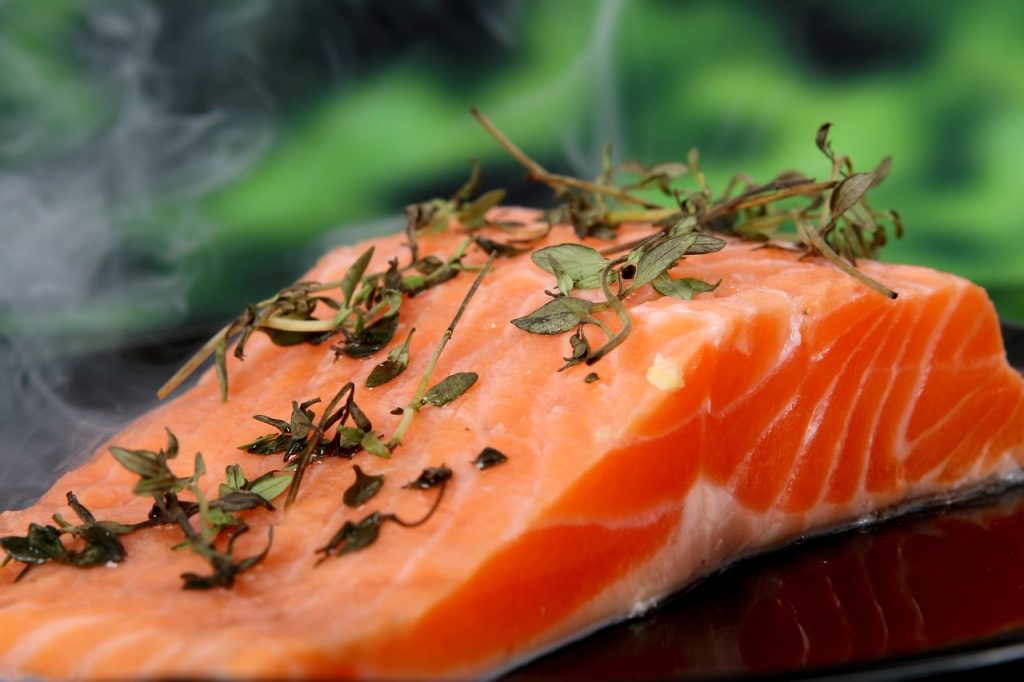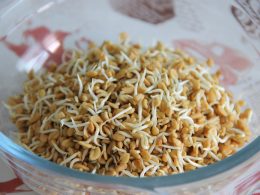Table of Contents
Salmon is a popular fish with a distinct pink color and a rich flavor that makes it a favorite among seafood lovers. However, besides being a delicious meal, salmon is also packed with numerous health benefits. Salmon is an excellent source of protein, vitamins, and minerals that are essential for optimal health. In this article, we will discuss the top health benefits of salmon.

What is Salmon?
Salmon is a type of fish that belongs to the family Salmonidae. There are several species of salmon, including Atlantic salmon, pink salmon, sockeye salmon, and coho salmon. Salmon is a popular fish, and it is consumed all over the world. Salmon is a rich source of omega-3 fatty acids, which are essential for optimal health.
Types of Salmon
Salmon is a type of fish that is found in various regions around the world. There are several different types of salmon, each with its own unique flavor and texture. In this article, we will discuss the various types of salmon that are commonly available.
Atlantic Salmon
Atlantic salmon, also known as Salmo salar, is the most popular type of salmon. It is primarily farmed in Norway, Scotland, and Chile. Atlantic salmon has a mild flavor and a medium-firm texture. It is commonly used in cooking and is often found in sushi.
Chinook Salmon
Chinook salmon, also known as king salmon or Oncorhynchus tshawytscha, is the largest species of Pacific salmon. It has a high fat content and a rich, buttery flavor. Chinook salmon is commonly found in Alaska, Canada, and the Pacific Northwest.
Coho Salmon
Coho salmon, also known as silver salmon or Oncorhynchus kisutch, has a medium fat content and a mild flavor. It is commonly found in Alaska, Canada, and the Pacific Northwest. Coho salmon is often used in smoking and grilling.
Sockeye Salmon
Sockeye salmon, also known as red salmon or Oncorhynchus nerka, has a deep red flesh color and a rich, full flavor. It is commonly found in Alaska, Canada, and the Pacific Northwest. Sockeye salmon is often used in sushi and smoked salmon dishes.
Pink Salmon
Pink salmon, also known as humpback salmon or Oncorhynchus gorbuscha, is the smallest and most abundant species of Pacific salmon. It has a low-fat content and a mild flavor. Pink salmon is commonly used in canning and is often found in salads and sandwiches.
Chum Salmon
Chum salmon, also known as dog salmon or Oncorhynchus keta, has a low-fat content and a mild flavor. It is commonly found in Alaska, Canada, and the Pacific Northwest. Chum salmon is often used in smoking and is commonly found in canned salmon.
Nutritional Fact of Salmon
Salmon is packed with essential nutrients that are beneficial for the body. A 100-gram serving of salmon contains:
- Calories: 208
- Protein: 20.5 grams
- Fat: 13.4 grams
- Saturated fat: 2.9 grams
- Omega-3 fatty acids: 2.3 grams
- Vitamin B12: 51% of the Daily Value (DV)
- Vitamin D: 127% of the DV
- Selenium: 78% of the DV
- Niacin: 25% of the DV
- Phosphorus: 25% of the DV
Health Benefits of Salmon

Boosts Heart Health
Salmon is an excellent source of omega-3 fatty acids, which are beneficial for heart health. Omega-3 fatty acids help to reduce inflammation, lower blood pressure, and prevent the formation of blood clots. The American Heart Association recommends eating at least two servings of fatty fish like salmon per week to reduce the risk of heart disease.
Promotes Brain Health
The omega-3 fatty acids found in salmon are also beneficial for brain health help to reduce inflammation and promote the growth and development of brain cells. Eating salmon can help to improve cognitive function and reduce the risk of cognitive decline and dementia.
Reduces Inflammation
Inflammation is a natural response of the body to injury or infection. However, chronic inflammation can contribute to the development of many chronic diseases, including cancer, diabetes, and heart disease. The omega-3 fatty acids found in salmon help to reduce inflammation in the body and prevent the development of chronic diseases.
Helps in Weight Loss
Salmon is a great food to include in your weight loss diet. It is high in protein, which can help to reduce appetite and increase feelings of fullness. Additionally, salmon is low in calories and fat, making it an excellent choice for those looking to lose weight.

Improves Eye Health
Salmon is also beneficial for eye health. It is a rich source of vitamin A, which is essential for eye health. Vitamin A helps to prevent age-related macular degeneration, which is a leading cause of blindness in older adults. Eating salmon regularly can help to improve vision and prevent eye diseases.
Boosts Immunity
Salmon is also beneficial for the immune system. It is a rich source of selenium, which is essential for immune function. Selenium helps to protect the body against oxidative stress and infection. Additionally, the omega-3 fatty acids found in salmon help to reduce inflammation in the body, which can boost the immune system.
Prevents Cancer
Salmon contains antioxidants and anti-inflammatory compounds that can help to prevent cancer. The omega-3 fatty acids found in salmon can also help to reduce the risk of colon, breast, and prostate cancer. Eating salmon regularly can help to reduce the risk of cancer and improve overall health.
Improves Skin Health
Salmon is also beneficial for skin health. The omega-3 fatty acids found in salmon help to keep the skin hydrated and prevent dryness and wrinkles. Additionally, the vitamin D found in salmon can help to improve skin tone and prevent skin damage caused by UV radiation.

Regulates Blood Sugar Levels
Salmon is a great food to include in a diabetic diet. It is low in carbohydrates and high in protein and healthy fats, which can help to regulate blood sugar levels. Additionally, the omega-3 fatty acids found in salmon can help to reduce inflammation in the body, which can improve insulin sensitivity and prevent diabetes.
Helps with Depression
Salmon is also beneficial for mental health. The omega-3 fatty acids found in salmon can help to reduce the symptoms of depression and anxiety. Eating salmon regularly can help to improve mood and reduce the risk of mental health disorders.
How to Include Salmon in Your Diet
Salmon can be prepared in many ways and is easy to include in your diet. Here are some ideas:
- Grilled salmon with vegetables
- Baked salmon with herbs and lemon
- Salmon burgers with whole-grain buns
- Salmon salad with mixed greens and avocado
- Smoked salmon with cream cheese on whole-grain bread
Healthy Recipes with Salmon

Grilled Salmon
Grilled salmon is a classic dish that is easy to make and full of flavor. To make grilled salmon, simply season the salmon with salt, pepper, and lemon juice, and then grill it over medium-high heat for about 6-8 minutes per side, or until the fish is cooked through.
Baked Salmon
Baked salmon is another easy and delicious way to prepare this fish. To make baked salmon, preheat your oven to 375°F. Season the salmon with salt, pepper, and any other herbs or spices you like, and then bake it for 12-15 minutes, or until the fish is cooked through.
Salmon Burgers
Salmon burgers are a fun and tasty way to enjoy salmon. To make salmon burgers, mix together fresh salmon, breadcrumbs, egg, green onion, and seasonings, and then form the mixture into patties. Grill or pan-fry the patties until they are cooked through, and then serve them on a bun with your favorite toppings.
Salmon Cakes
Salmon cakes are similar to salmon burgers, but they are typically made with canned salmon instead of fresh. To make salmon cakes, mix together canned salmon, breadcrumbs, egg, mayonnaise, and seasonings, and then form the mixture into patties. Fry the patties in a pan until they are golden brown, and then serve them with tartar sauce.
Salmon Poke Bowl
A salmon poke bowl is a delicious and healthy way to enjoy salmon. To make a poke bowl, simply dice the salmon and mix it with cooked rice, vegetables, and a soy sauce-based dressing. Top the bowl with avocado, sesame seeds, and any other toppings you like.
Side Effect of salmon
Mercury Contamination
Salmon, especially larger varieties like king and Atlantic salmon, can contain high levels of mercury due to pollution in the oceans. Mercury is a toxic metal that can accumulate in the body and cause neurological and developmental problems, especially in children and pregnant women. To minimize your exposure to mercury, it is recommended to limit your consumption of high-mercury fish, including certain types of salmon.
Foodborne Illness
Like all types of fish, salmon can carry bacteria and viruses that can cause foodborne illness, such as salmonella and norovirus. To reduce the risk of foodborne illness, it is important to properly store, handle, and cook salmon. Always purchase salmon from a reputable source, keep it refrigerated or frozen, and cook it to an internal temperature of 145°F.
Allergic Reactions
Some people may have an allergic reaction to salmon or other types of fish. Symptoms of a fish allergy can include hives, swelling, nausea, and difficulty breathing. If you suspect you may be allergic to salmon, it is important to avoid it and seek medical attention if you experience any symptoms.
Interference with Blood Thinners
Salmon contains high levels of omega-3 fatty acids, which have blood-thinning properties. While this can be beneficial for heart health, it can also interfere with blood-thinning medications like warfarin. If you are taking blood thinners, it is important to consult with your doctor before consuming large amounts of salmon or other fish.
FAQs
Is salmon safe to eat raw?
It is not recommended to eat raw salmon, as it may contain harmful bacteria.
How much salmon should I eat per week?
The American Heart Association recommends eating at least two servings of fatty fish like salmon per week.
Can I eat salmon if I have a fish allergy?
If you have a fish allergy, it is best to avoid eating salmon and other types of fish to prevent an allergic reaction.
Is canned salmon as nutritious as fresh salmon?
Canned salmon is just as nutritious as fresh salmon, as long as it is not high in sodium or added preservatives.
What is the best way to cook salmon?
Salmon can be prepared in many ways, including grilling, baking, poaching, or pan-searing. It is best to choose a cooking method that preserves the nutritional value of the fish while also making it taste delicious.
Conclusion
salmon is a highly nutritious and delicious fish that can offer a wide range of health benefits. By incorporating this healthy food into your diet regularly, you can enjoy better heart health, brain health, weight loss, improved immune system function, and much more. Whether you prefer fresh or canned salmon, there are plenty of ways to prepare this versatile fish and enjoy its many health benefits. So go ahead and add more salmon to your diet today!















